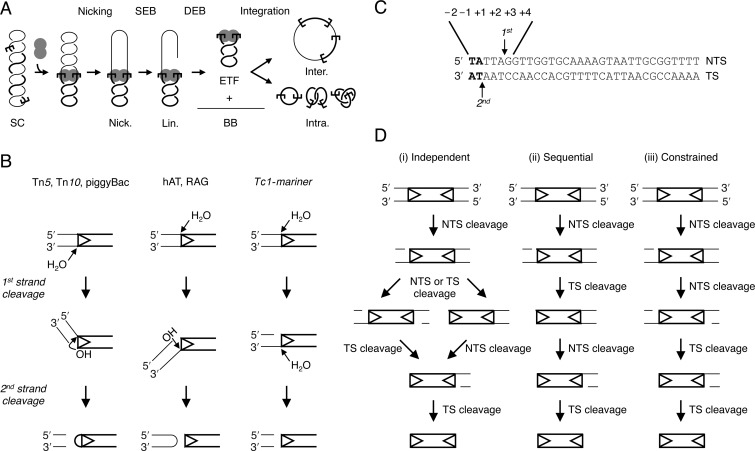Figure 1.
Cut-and-paste transposition and the mechanisms of double-strand cleavage at transposon ends. (A) A cartoon of mariner transposition with a supercoiled (SC) substrate as a transposon donor. The transpososome assembles two transposon ends and a transposase dimer. Non-transferred strand (NTS) nicking generates an open circular product (Nick.). Transferred strand (TS) nicking at one end yields the linear SEB product (Lin.). A similar set of nicks at the other transposon end yields the two double-end break (DEB) products, which are the plasmid backbone (BB) plus the excised transposon fragment (ETF). Examples of inter- and intra-molecular integration products are illustrated (8,14). (B) Three mechanisms for DSB formation in DNA transposition (17). Single transposon ends are represented as double-stranded DNA. Transposon DNA is shown as thick lines, flanking DNA as thin lines, transposon ends as arrowheads. Tn5 and Tn10 in bacteria and piggyBac in eukaryotes cleave the TS (bottom strand) first. The resulting 3′-OH is used as a nucleophile to attack the opposite DNA strand, which generates a hairpin at the transposon end. Eukaryotic hAT elements and RAG proteins use a reverse hairpin intermediate. The NTS (top strand) is cleaved first and the resulting 3′-OH attacks the opposite strand to give a hairpin on the flanking DNA. Members of the Tc1-mariner superfamily do not use a hairpin intermediate. The NTS is cleaved first then the second strand break occurs by a second hydrolysis reaction. (C) Sequence and cleavage sites of the Hsmar1 transposon end. The NTS is cleaved preferentially 3-bp within the transposon ends. The TS is then cleaved exactly at the intersection between the transposon and the flanking DNA, as indicated by the arrows (24,29). Tc1-mariner elements are also flanked by symmetrical TA dinucleotides, which result from the duplication of the target site upon integration (26). Nucleotide numbering of the NTS is indicated. (D) Three possible models for the order of catalytic events during cleavage of the mariner transposon. The NTS is always cleaved before the TS at a given transposon end (panel B). Cleavage events at the two ends can either be (i) independent, (ii) sequential, with one end always cleaved before the other, or (iii) constrained, with both NTS always cleaved before cleavage of the first TS.

